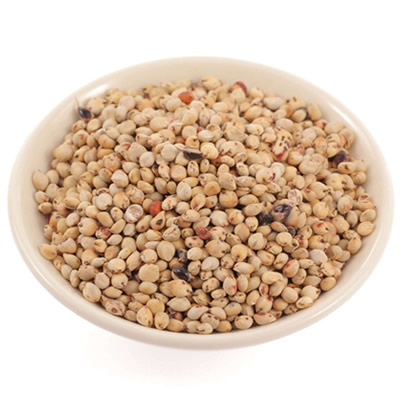White Sorghum Flour
Also Known as Milo or Jowar Flour
What is White Sorghum Flour?
White sorghum flour is a gluten-free, GMO-free, ancient grain flour. It has been gaining popularity as a partial substitute for traditional flour in gluten-free recipes. Other favorable attributes of white sorghum flour include its light color, neutral flavor, and nutrition profile.
Since it does not contain the gluten proteins that serve as binders in traditional flour, retail sorghum flour contains ingredients such as xanthan gum or starches to make it ready-to-use. Commercial food companies add these items separately to make their own proprietary blends.
Origin
Sorghum’s existence is traced back to 8000 BC.1 The sorghum plant is environmentally friendly and sustainable since it is drought resistant and requires minimal to no irrigation.
In Africa and Asia, sorghum is the preferred grain for use in the human diet. In the United States, this grain finds more use in animal feed. Sorghum’s lengthy cooking process and the flour’s unavailability have limited its incorporation into the human diet.2
Sorghum is one of the top five cereal crops in the world. Currently, the United States is one of the largest producers of this grain with 480 million bushels being produced in 2016.3 Recently, as consumer demands change, use of sorghum in the food industry has increased three fold.
Function
Sorghum lacks the gluten proteins necessary for some baked goods, therefore the addition of binders may be necessary. For every one cup sorghum used in cookies, try to use one-half teaspoon of xanthan gum as a binder. In bread, increase this amount to one teaspoon.4 Other binder options include egg whites, unflavored gelatin, corn starch or guar gum.
Nutrition
100 grams of white sorghum flour provides approximately 350 kcal, 2 grams of fiber, 10 grams of protein and 1 gram of fat. It is also a good to excellent source of many micronutrients and B-complex vitamins.5
Commercial production
White Sorghum grain is hulled and milled similarly to other traditional flours. The tan or white grain used for milling must meet the food grade safety standards outlined in Codex Alimantarius.6
Application
White sorghum flour finds use in traditional bakery items such as bread, cakes, cookies, tortillas and pizza. The wheat flour in cakes can be exchanged directly for sorghum flour with favorable results.2 In other baked goods, a direct one to one substitution of sorghum for wheat flour does not give favorable results. Instead, blending of sorghum with starches from tapioca, rice or chickpea flour is best. For example:
- White sorghum flour in combination with potatoes starch or tapioca and gums can be used effectively in formulating gluten-free baked goods and tortillas.7
- Bread with optimum softness and crumb grain can be obtained by adding cornstarch to sorghum flour at a ratio of 0.55, water at 90% and 3%HPMC (hydroxypropylmethylcellulose).8
- A blend of sorghum and millet flours were found to be the most acceptable replacement for traditional wheat flour in gluten-free cookies.2
References
- Rooney L, Bean S, Turner N, Haub M, Dahlberg J, Weller C, Awika J, Smail V. “Sorghum: An Ancient, Healthy and Nutritious Old World Cereal.” 2010, http://sorghum.ucanr.edu/data/files/Sorghum%20Ancient%20Grain%20Final%209-16-10.pdf. Accessed 30 Oct. 2018.
- Ratnavathi CV, Patil JV. ”Sorghum Utilization as Food”. J Nutr Food Sci, 4: 247, 2013. doi: 10.4172/2155-9600.1000247
- United Sorghum Checkoff. “All about Sorghum.” 2016. http://www.sorghumcheckoff.com/all-about-sorghum, Accessed 30 Oct. 2018.
- Rees J, Henneman A. “How to Bake Gluten Free with Sorghum.” University of Nebraska, Lincoln Extension Publication, https://food.unl.edu/how-bake-gluten-free-sorghum. Accessed 30 Oct. 2018.
- United States Department of Agriculture. National Nutrient Database, 20650 Sorghum flour, refined, unenriched. https://ndb.nal.usda.gov, Accessed 30 Oct. 2018.
- Joint FAO/WHO Codex Alimentarius Commission. Codex Alimentarius. Standard for Sorghum Flour, 173-1989,1995. http://www.fao.org/fao-who-codexalimentarius/codex-texts/all-standards/en/
- Velázquez N, Sánchez HD, Osella CA, Santiago LG. Velázquez, Noemí, Hugo Sánchez, Carlos Osella, and Liliana G. Santiago. “Using white sorghum flour for gluten-free breadmaking.” International Journal of Food Sciences and Nutrition, 63.4, 2012, pp. 491-497.
- Rai S. Kaur A. Singh B. “Quality characteristics of gluten free cookies prepared from different flour combinations.” Journal of Food Science and Technology, 51(4), 2011, pp 785-789.


